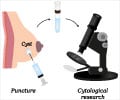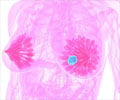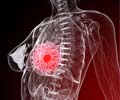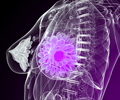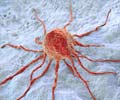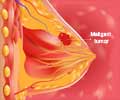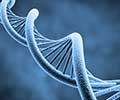Glossary
Areola: The area of dark-colored skin on the breast that surrounds the nipple.Aspirate: Fluid withdrawn from a lump, often a cyst, or a nipple.
Axilla: The underarm or armpit.
Axillary: Pertaining to the armpit area, including the lymph nodes that are located there.
Axillary lymph node dissection: Surgery to remove lymph nodes found in the armpit region. Also called axillary dissection.
Benign: Not cancerous; does not invade nearby tissue or spread to other parts of the body.
Biological therapy: Treatment to stimulate or restore the ability of the immune system to fight infection and disease. Also used to lessen side effects that may be caused by some cancer treatments. Also known as immunotherapy, biotherapy, or biological response modifier (BRM) therapy.
Biopsy: The removal of cells or tissues for examination under a microscope. When only a sample of tissue is removed, the procedure is called an incisional biopsy or core biopsy. When an entire tumor or lesion is removed, the procedure is called an excisional biopsy. When a sample of tissue or fluid is removed with a needle, the procedure is called a needle biopsy or fine-needle aspiration.
Bone marrow: The soft, sponge-like tissue in the center of bones that produces white blood cells, red blood cells, afree of cancer cells. nd platelets.
Cancer: A term for diseases in which abnormal cells divide without control. Cancer cells can invade nearby tissues and can spread through the bloodstream and lymphatic system to other parts of the body.
Clear margins: The normal tissue around the tumor, which is free of cancer cells.
Cyst: A sac or capsule filled with fluid.
Estrogen: Female sex hormone produced primarily by ovaries and in smaller amounts by conversion of male hormone made in the adrenal gland. In breast cancer, estrogen may promote the growth of cancer cells.
HER 2: a gene that helps control the growth and repair of cells.
Hormone: Chemical substance produced in the body by glands. Hormone travels through the blood stream and sets in motion various body functions.
Immune system: Body's own system for fighting diseases.
Lymph node: A rounded mass of lymphatic tissue that is surrounded by a capsule of connective tissue. Also known as a lymph gland. Lymph nodes are spread out along lymphatic vessels and contain many lymphocytes, which filter the lymphatic fluid (lymph).
Lymphatic system: The tissues and organs that produce, store, and carry white blood cells that fight infection and other diseases. This system includes the bone marrow, spleen, thymus, lymph nodes, and network of thin tubes that carry lymph and white blood cells. These tubes branch, like blood vessels, into all the tissues of the body.
Menarche: Age of attaining puberty.
Menopause: Age when menses stops.
Nulliparous: Women who have no children.
Progesterone: Female sex hormone released by the ovaries during every menstrual cycle to prepare the uterus for pregnancy and the breasts for milk production.
Reconstructive Surgery: Women who had mastectomy (removal of breast) reconstruct their breast by rebuilding it in two ways.
- with implants filled with fluid or gel (or)
- with tissue taken from the belly or back.
SERM: (Selective estrogen receptor modulators) - drugs that blocks estrogen by filling up its receptors on breast cancer cells. This can help stop or slow down the growth of hormone-receptor-positive breast cancer.
Stage: The extent of a cancer, especially whether the disease has spread from the original site to other parts of the body. It is important to know the stage of the disease in order to plan the best treatment.



